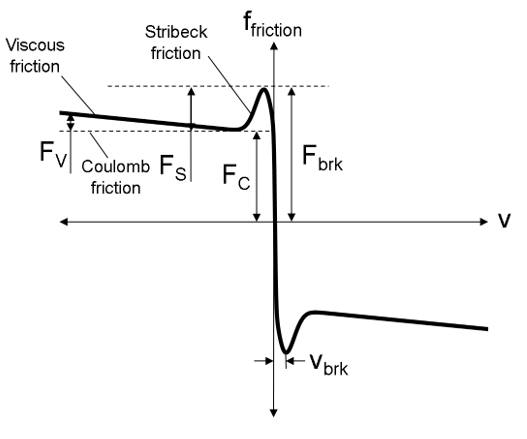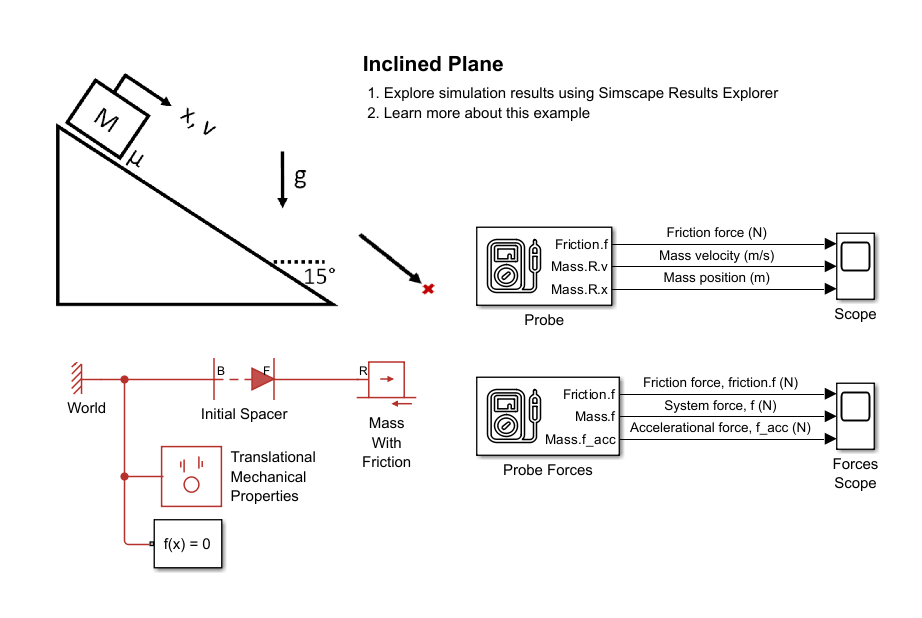Translational Friction (PB)
Resistive frictional contact between surfaces in position-based mechanical translational systems
Since R2024b
Libraries:
Simscape /
Foundation Library /
Translational /
Elements
Description
The Translational Friction (PB) block represents resistive frictional contact between surfaces.
The friction force is a function of relative velocity and is assumed to be the sum of Stribeck, Coulomb, and viscous components, as shown in the figure.

The Stribeck friction, FS, is the negatively sloped characteristics taking place at low velocities [1]. The Coulomb friction, FC, results in a constant force at any velocity. The viscous friction, FV, opposes motion with the force directly proportional to the relative velocity. The sum of the Coulomb and Stribeck frictions at the vicinity of zero velocity is the breakaway friction, Fbrk.
You specify the normal force, FN, which acts on the block in the direction normal to the rail, that is, normal to the direction of the motion. The block calculates the breakaway friction force and the Coulomb friction force based on the normal force and the proportionality coefficients that you also specify. The normal force can be either constant or variable.
The friction is approximated with the following equations:
where:
ffriction is the friction force.
FN is the normal force, which acts on the block in the direction normal to the rail, that is, normal to the direction of the motion.
FC is the Coulomb friction.
KC is the Coulomb friction coefficient.
Fbrk is the breakaway friction.
Kbrk is the breakaway friction coefficient.
fv is the viscous friction coefficient.
vbrk is the breakaway friction velocity.
vSt is the Stribeck velocity threshold.
vCoul is the Coulomb velocity threshold.
v is the relative velocity.
vB and vF are the absolute velocities of ports B and F, respectively.
length is the friction length.
xB and xF are the absolute positions of ports B and F, respectively.
power_dissipated is the power dissipated through the friction.
The negative sign in the first equation reflects the force flow conventions used in the position-based mechanical translational domain. Unless the ports have inverted, a positive value of ffriction indicates that the block is in a state of compression and a negative value of ffriction indicates that the block is in a state of tension. For more information, see Two-Port Block Orientation and Force Flow Conventions.
The exponential function used in the Stribeck portion of the force equation is continuous and decays at velocity magnitudes greater than the breakaway friction velocity.
The hyperbolic tangent function used in the Coulomb portion of the force equation ensures that the equation is smooth and continuous through v = 0, but quickly reaches its full value at nonzero velocities.
Connections B and F are position-based mechanical translational conserving ports. The friction force acts from port B on port F. Positive friction force drives port F in the positive direction. You can specify the normal force either by using the Normal force parameter or by using the physical signal port N.
Variables
To set the priority and initial target values for the block variables prior to simulation, use the Initial Targets section in the block dialog box or Property Inspector. For more information, see Set Priority and Initial Target for Block Variables.
Nominal values provide a way to specify the expected magnitude of a variable in a model. Using system scaling based on nominal values increases the simulation robustness. Nominal values can come from different sources, one of which is the Nominal Values section in the block dialog box or Property Inspector. For more information, see Modify Nominal Values for a Block Variable.
Examples
Ports
Input
Conserving
Parameters
References
[1] Armstrong, B. and C.C. de Wit, Friction Modeling and Compensation, The Control Handbook, CRC Press, 1995.
Extended Capabilities
Version History
Introduced in R2024b

